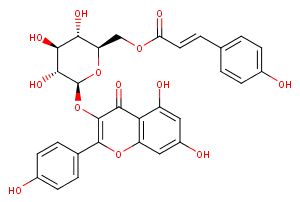Tiliroside
| Code | Size | Price |
|---|
| TAR-T5S1172-5mg | 5mg | £122.00 | |||||||||||||||||||||||||||||||||||||||||||||||||||||||||||||||||||||||||||||||||||||||||||||||||
| Special offer! Add £1 to your order to get a TargetMol CCK-8 Kit. Read more here. | |||||||||||||||||||||||||||||||||||||||||||||||||||||||||||||||||||||||||||||||||||||||||||||||||||
Quantity:
| TAR-T5S1172-10mg | 10mg | £161.00 | |||||||||||||||||||||||||||||||||||||||||||||||||||||||||||||||||||||||||||||||||||||||||||||||||
| Special offer! Add £1 to your order to get a TargetMol CCK-8 Kit. Read more here. | |||||||||||||||||||||||||||||||||||||||||||||||||||||||||||||||||||||||||||||||||||||||||||||||||||
Quantity:
| TAR-T5S1172-25mg | 25mg | £227.00 | |||||||||||||||||||||||||||||||||||||||||||||||||||||||||||||||||||||||||||||||||||||||||||||||||
| Special offer! Add £1 to your order to get a TargetMol CCK-8 Kit. Read more here. | |||||||||||||||||||||||||||||||||||||||||||||||||||||||||||||||||||||||||||||||||||||||||||||||||||
Quantity:
| TAR-T5S1172-50mg | 50mg | £321.00 | |||||||||||||||||||||||||||||||||||||||||||||||||||||||||||||||||||||||||||||||||||||||||||||||||
| Special offer! Add £1 to your order to get a TargetMol CCK-8 Kit. Read more here. | |||||||||||||||||||||||||||||||||||||||||||||||||||||||||||||||||||||||||||||||||||||||||||||||||||
Quantity:
| TAR-T5S1172-100mg | 100mg | £436.00 | |||||||||||||||||||||||||||||||||||||||||||||||||||||||||||||||||||||||||||||||||||||||||||||||||
| Special offer! Add £1 to your order to get a TargetMol CCK-8 Kit. Read more here. | |||||||||||||||||||||||||||||||||||||||||||||||||||||||||||||||||||||||||||||||||||||||||||||||||||
Quantity:
Prices exclude any Taxes / VAT
Overview
Regulatory Status: RUO
Shipping:
cool pack
Storage:
-20℃
Images
Documents
Further Information
Bioactivity:
1. Potengriffioside A shows anticarcinogenic activity. 2. Potengriffioside A shows hepatoprotective activity. 3. Potengriffioside A shows antioxidant and anti-inflammatory activity, can inhibit neuroinflammation in neurodegenerative disorders. 4. Potengriffioside A has anti-diabetic effect, are at least partially mediated through inhibitory effects on carbohydrate digestion and glucose uptake in the gastrointestinal tract. 5. Potengriffioside A and gnaphaliin are antioxidants against in vitro Cu(2+)-induced LDL oxidation in the same order of magnitude compared to that of the reference drug, probucol. 6. Potengriffioside A enhances fatty acid oxidation via the enhancement adiponectin signaling associated with the activation of both AMP-activated protein kinase and peroxisome proliferator-activated receptor α and ameliorates obesity-induced metabolic disorders.
CAS:
20316-62-5
Formula:
C30H26O13
Molecular Weight:
594.525
Pathway:
oxidation-reduction
Purity:
0.98
SMILES:
O[C@@H]1[C@@H](COC(=O)C=Cc2ccc(O)cc2)O[C@@H](Oc2c(oc3cc(O)cc(O)c3c2=O)-c2ccc(O)cc2)[C@H](O)[C@H]1O
Target:
Antioxidant
References
Goto T , Teraminami A , Lee J Y , et al. Tiliroside, a glycosidic flavonoid, ameliorates obesity-induced metabolic disorders via activation of adiponectin signaling followed by enhancement of fatty acid oxidation in liver and skeletal muscle in obese?diabetic mice[J]. Journal of Nutritional Biochemistry, 2012, 23(7):0-0.



